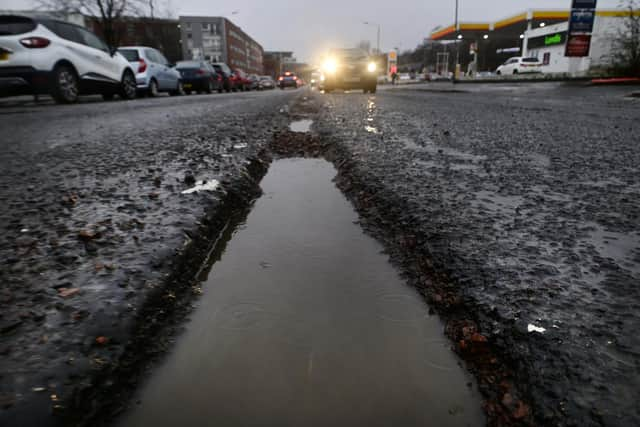Potholes Scotland: What are the worst areas for potholes in Scotland? Busiest Edinburgh and Glasgow roads show improvements
More than one in four of the busiest roads maintained by Scotland’s councils need repairs, but official figures have shown conditions have improved in more than half of their areas since last year, The Scotsman has learned.
In findings which might be met with disbelief among drivers, main streets in both Edinburgh and Glasgow were among those found to be in a better state, by up to 3 percentage points.
Advertisement
Hide AdAdvertisement
Hide AdOverall, non-trunk A roads improved by 0.2 points, leaving 27.4 per cent classed as “should be considered for maintenance treatment”. B roads were 2.1 points better with 31.5 per cent needing work, C roads were 0.5 points improved at 32.7 per cent and unclassified minor roads 0.3 per cent better at 36.4 per cent.
Among A roads, there was a wide variation between councils, with best-performing Shetland having only 13.4 per cent needing work compared to Argyll and Bute’s 37.4 per cent. Scottish Borders was next worst at 34.7 per cent.
South Ayrshire was the most improved council for A roads, with a near 6 point fall in those needing repair to 23 per cent, while Midlothian’s deteriorated the most, by 5 points to 29.3 per cent.
Glasgow’s A roads, which include the A82 Great Western Road and the A8 Alexandra Parade, were 2.8 points better with 28.4 per cent requiring work. Edinburgh’s equivalent roads, which include A700 Lothian Road and the A1 London Road, were 2.2 points better at 27.4 per cent.
The Improvement Service (IS), which advises local authorities and published the figures, said total annual council spending on road maintenance had fallen by 9 per cent since 2010 – a reduction of more than £70 million to £685m.


It said: “Councils are having to make increasingly difficult decisions about the shape and level of service delivery as a result of deepening fiscal, workforce and demand pressures. Ringfenced funding for Scottish Government priorities means that councils are left with little option, but to target increased savings in other areas.”
Neil Greig, the Scotland-based policy adviser to the IAM RoadSmart motoring group, was impatient for faster improvements.
He said: “Most surveys of drivers show confidence in the ability of local authorities to maintain our roads is at an all-time low. The proportion in need of work has hardly shifted in the last six years despite the millions thrown at it in emergency pothole funds and other crisis funding. This underlines the need for a long-term approach to eliminating the backlog of road maintenance on Scotland’s local roads.”
Advertisement
Hide AdAdvertisement
Hide AdArgyll and Bute Council said its roads had “steadily improved” over the past eight years, but nearly one quarter were built on peat, which made repairs more complex.
A spokesperson for Scottish Borders Council said it wasn’t able to make permanent repairs to all defects and had to “apply a prioritisation process to determine our annual programme, which meets available budgets”.
It said the durability of temporary repairs “can be severely impacted by periods of inclement weather”.
Edinburgh City Council transport convener Scott Arthur, who has admitted the capital’s roads were in a “shameful” state, said the figures showed its repairs were having a “real impact”.
He said: “It looks like we may have halted the decline in road and footpath conditions.”
"In fact, we’re on track to improve more square metres of roads and pavements than in any other financial year in 2023-24.
"As a result the rating of the condition of our entire road network, the Road Condition Index (RCI), has also continued to improve year on year. Indeed, the data indicates that improvements in Edinburgh have exceeded those in 29 of Scotland's 32 local authorities.
“That’s in part thanks to an additional £11m of capital investment committed in last year’s budget and this year we’ve gone even further to pledge £12.5m to tackling poor road and pavement surfaces, which will help us to deliver a safe, usable network.”
Advertisement
Hide AdAdvertisement
Hide AdA spokesman for Glasgow City Council said: “The road maintenance survey for local authority roads is conducted independently and the survey has consistently shown that Glasgow’s network has performed above the national rate for acceptable road condition in recent years.
“There is a direct link between road condition and environmental factors such as ice, rain and volume of traffic.
“Following the lowest road surface temperatures in a decade in December 2022, an extended period of heavy rain led to a sharp rise in pothole reports in January 2023.
“To address these road conditions, the road maintenance budget for 2023-24 was doubled to £12m and this will ensure 175 resurfacing projects across the city will be completed by the end of this financial year.
“The winter period is always a challenging time for road conditions but pothole reports have not risen this year in the way they did in early 2023.
“We continue to take a risk-based approach to road maintenance with the most serious faults repaired as a matter of priority.”
Comments
Want to join the conversation? Please or to comment on this article.